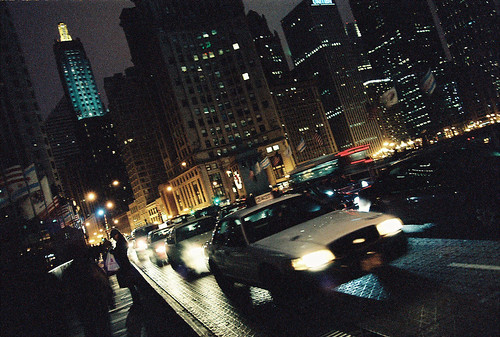

A very rough guide and initiation for those new to digital photography and to the Nikon D700. This site is absolutely independent, and unaffiliated with Nikon and its distributors in the whole wide world.





Above are some old images, made with my Nikon F5 and my AF-S 24-120 VR on Kodak tungsten film ISO 160, in December 2007, in Chicago, in the midst of a hellish winter. These images show (gasp!) grain. In fact, the grain here is just gorgeous... and makes me wonder about the reasons, the legitimate reasons why I fell in love with sharpness.
And now, one that stands out, at least to me:
In this photograph of the Dearborn Bridge in Chicago, there was a lot of grain in the lower right corner before I tinkered with it. While I was initially annoyed about it, suddently I realized that this precise aspect drew me to certain images: grain, like the painter's strokes, is not a problem here, not something to eschew, but the artist's "signature", the proof that we're not looking at nature itself, but at something that represents a particular subjectivity.
Pretty nice, huh? Grain, as opposed to what others term "coldness" or "impure perfection", separates two different media. Digital gives us a perfect image, but film is still a personal choice. Since this film has a slow ISO (just 160), what would the photos be like with, say, a typical B&W ISO 400? Grain galore... Does it mean "imperfection" or is it just an interpretive view?
What do you think now?


I can report that the D700 worked wonders in very low temperatures. The manual shows that the camera can work at 32°F, but then, any given camera can perform at this temperature. The fact that this one, just like other Nikon bodies, can work flawlessly at something like 12°F really means the world to me. Nice it is to add that the battery didn't lose significant amounts of power here: it left the house and came back at the exact same level. Granted, it was not a long walk... after all, I am not insensitive to cold!
Other findings: forget about perfect WB. That's not a thing with this camera alone. It's a problem with digital. I recall some of the playful shots I made with a small Lumix under different light conditions and they showed a peculiar color cast. Just in case, readers recently converted to digital (like me) expect a magical rendition of color under challenging lighting conditions... rest assured that it won't happen. Digital sensors ain't that smart.
More to come as I make a little more time.


 This one was different. The lens wasn't completely extended to the longest, and the window was letting in a fairly strong bit of sun, so I used my built-in flash here. No D-Lighting trick was necessary, as the photograph looks good on my screen and in print.
This one was different. The lens wasn't completely extended to the longest, and the window was letting in a fairly strong bit of sun, so I used my built-in flash here. No D-Lighting trick was necessary, as the photograph looks good on my screen and in print.
 These two girls looked friendly enough to say yes to my request to photograph them. Since I was in a bit of a hurry, I focused on the one on the right, and compensated the exposure by opening it two thirds (the D700 has the Easy-Exposure feature on). That will explain the blown highlights behind them.
These two girls looked friendly enough to say yes to my request to photograph them. Since I was in a bit of a hurry, I focused on the one on the right, and compensated the exposure by opening it two thirds (the D700 has the Easy-Exposure feature on). That will explain the blown highlights behind them.
Portraiture does not need to be with long lenses only, and this zoom just proves that. Of course, there's the operator's skill at play here... but that's enough for another day, when we deal with urban 'scapes. In the meanwhile, I will keep using long lenses for anything but portraiture, and wide-angles for people shots. Why not?